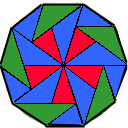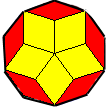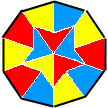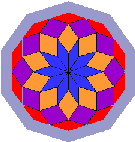 
After an energetic year of new products in 1993, we were on a roll and produced 12 new products in 1994. A large number of them were devoted to our latest passion—tiling sets based on the golden ratio. And we continued the current trend of making large, gala objects, with a dynamic presence.
We had gotten intrigued and enchanted by the mathematics of the golden ratio, phi and the lure of Penrose tiles, and finally pulled together several large kits and art pieces based on phi. Our technique of lasercutting the tiles out of acrylic gave these sets a striking beauty of gleaming color in a mosaic of well-balanced size. These sets formed the core of a whole new category for our ever-growing catalog: the Pentagon Universe.
The golden ratio as art
- CollidescapeTM — the two golden triangles that are the basis of all the other sets were researched by our associate and consultant of that time period, Edward Hollins, a magician by trade and a talented artist who created many of the illustrations and designs for these sets.
 To go along with the "fiveness" of these golden sets (they were naturals to form pentagons), we decided also to include 5 colors. Following the rough proportion of the golden ratio, 1.618..., we packaged them in pods of 8 tiles, consisting of 3 tall and 5 wide isosceles triangles, the approximate ratio of their occurrence in any tiling. The relative dimensions of the triangles with their own sides and with each others' all were according to the endless decimal of phi. And because any activity of exploring such tilings required a large number of pieces, we made the starter set with 25 pods.
To go along with the "fiveness" of these golden sets (they were naturals to form pentagons), we decided also to include 5 colors. Following the rough proportion of the golden ratio, 1.618..., we packaged them in pods of 8 tiles, consisting of 3 tall and 5 wide isosceles triangles, the approximate ratio of their occurrence in any tiling. The relative dimensions of the triangles with their own sides and with each others' all were according to the endless decimal of phi. And because any activity of exploring such tilings required a large number of pieces, we made the starter set with 25 pods.
- Penrose Diamonds — two shapes of rhombs, 36 and 72 degrees, were based on the research of Roger Penrose, the world-famous astrophysicist knighted by the Queen of England for his work on black holes and superstrings. Among his passions was the search for non-periodic patterns, which worked best with tiles of five-fold symmetry.
 Roger's search was for the fewest number of different tile shapes that would produce non-periodic tilings, and he eventually whittled them down to 2 shapes in a couple of different ways. The first pair were these rhombs. Interesting that each rhomb is actually built of two golden triangles joined at their base. These, too, lent themselves to making pods of 8 tiles— 5 thick and 3 thin rhombs. Start with 20 pods, and you'll soon want the 50-pod set for soul-satisfying patternings. To be entirely fair, we must admit that we neglected to add markings on the tiles that would forbid certain adjacencies and thus guarantee non-periodicity. Without those marks it is easy to convert a tiling to the regularity of a checkerboard. We were incredibly fortunate to be able to include in the manual the entire text of the first two chapters of Martin Gardnerís book, Penrose Tiles to Trapdoor Ciphers (W.H. Freeman and Co., New York, 1989), and Robert Clasonís article in The Mathematical Gazette (July 1994). We thank Martin Gardner and Bob Clason for their permission to use this material to accompany Kadonís sets of Penrose tiles.
Roger's search was for the fewest number of different tile shapes that would produce non-periodic tilings, and he eventually whittled them down to 2 shapes in a couple of different ways. The first pair were these rhombs. Interesting that each rhomb is actually built of two golden triangles joined at their base. These, too, lent themselves to making pods of 8 tiles— 5 thick and 3 thin rhombs. Start with 20 pods, and you'll soon want the 50-pod set for soul-satisfying patternings. To be entirely fair, we must admit that we neglected to add markings on the tiles that would forbid certain adjacencies and thus guarantee non-periodicity. Without those marks it is easy to convert a tiling to the regularity of a checkerboard. We were incredibly fortunate to be able to include in the manual the entire text of the first two chapters of Martin Gardnerís book, Penrose Tiles to Trapdoor Ciphers (W.H. Freeman and Co., New York, 1989), and Robert Clasonís article in The Mathematical Gazette (July 1994). We thank Martin Gardner and Bob Clason for their permission to use this material to accompany Kadonís sets of Penrose tiles.
- Penrose Kites & Darts — Roger's second pair of tiles were also made of pairs of golden triangles, this time joined on their sides. Roger's version had markings to prevent the kite and dart from forming a rhombus. For aesthetic reasons we have omitted the marks.
 As with the rhombs, we packaged the kites and darts as pods of 5 kites, 3 darts, in 5 colors, in a starter set of 20 pods. Then a friend and customer, Nancy Van Schooenderwoert, showed us a brilliant game she had created to play with the set on a mat showing one of the famous symmetrical but non-periodic tiling patterns for kites and darts. It takes the master set of 40 pods, accommodates 5 players, and won Games magazine's award as one of the 100 best games of 2005. What a thrill!
As with the rhombs, we packaged the kites and darts as pods of 5 kites, 3 darts, in 5 colors, in a starter set of 20 pods. Then a friend and customer, Nancy Van Schooenderwoert, showed us a brilliant game she had created to play with the set on a mat showing one of the famous symmetrical but non-periodic tiling patterns for kites and darts. It takes the master set of 40 pods, accommodates 5 players, and won Games magazine's award as one of the 100 best games of 2005. What a thrill!

- Deka-StarTM — To bring these tiles within reach of casual players and even kids as young as 6, Kate designed a small decagon of 40 Penrose diamonds, the two shapes in 4 colors, in their own framed tray. They can form a galaxy of exquisite designs. It turned out to be a very popular puzzle and is continuing so even after 25 years. This year we've decided to give it a silver tray.
- Rhom-AnticsTM —
 This glorious embodiment of thick and thin Penrose diamonds with edge colors, 45 of each size, in 23" frame, was also the brainchild of Ed Hollins, developed by Kate into a major work of art where matching of edge colors produced a dazzling decagon like a floating globe. Here was a worthy subject for the mirrored acrylics we had recently discovered. It was well worth all the effort of inlaying it by hand with 360 individual triangles.
This glorious embodiment of thick and thin Penrose diamonds with edge colors, 45 of each size, in 23" frame, was also the brainchild of Ed Hollins, developed by Kate into a major work of art where matching of edge colors produced a dazzling decagon like a floating globe. Here was a worthy subject for the mirrored acrylics we had recently discovered. It was well worth all the effort of inlaying it by hand with 360 individual triangles.
Big gala beauties
- Rainbow Rombix® — 36 unique rhombic tiles fill the 24-sided tray with 6 vivid colors. We made this most complex of our Rombix series because a friend had asked to have a version in rainbow colors. Voilŗ! The mathematical principle of "rhombic circle tiling" discovered by mathematician Alan Schoen shows in this grand version even more than in the smaller sets. Six sizes of rhombs, with each single leading a group of 5 twins of its color, each color of equal area, and the exquisite parallel longitudinal stripes and latitudinal arcs giving it a three-dimensional look. We're satisfied that we would not ever want to make a Rombix bigger than this!
- Royal Game of the Goose/Labyrinth (tapestry) — This canvas version of our deluxe wood Renaissance game, backed by the 3500-year-old Labyrinth game, makes a fine wall tapestry. It can roll like a scroll in its fabric bag or hang from its cord like a board. Decorative no matter which side shows. We decided that after seven years of offering the wood version, at the Maryland Renaissance Festival it would be helpful to offer a lower-priced "pauper's edition" as well. The smooth, water-repellent canvas in earth colors was ideal. And the two sides were screen-printed in different colors to give them each their own personalities. Flat gem-like marbles in six colors were just the right touch. For their Silver Anniversary year, we thought we'd include some silver extras.

- Dual Quintachex®
— The original Quintachex that Kate invented more as a joke turned into a real and serious puzzle challenge, with the 12 pentominoes checkerboarded on both sides, but sometimes with the colors reversed on the back. Then someone suggested that it would be nice to have both sides available simultaneously. Now that would be twice the 60 squares, or 120 squares in area. Oh, let's add one more square and make it a pretty 11x11 square. But how to deal with the fact that the original Quintachex had a division of the colors 63/65, not an even 64? For the 11x11, if the singleton joins the 63 group and makes it 64, then the parity problem disappears and it should work with perfect checkerboarding throughout. And so it was. For artistic interest, we made them all wavy instead of boringly straight, and the 24 checkerboarded, wavy pentominoes turned into one of our most sophisticated sets. No, we don't know how many solutions it has, though we've found more than one.
 Classic strategy Classic strategy

- AmazonsTM — Invented by Walter Zamkauskas, an Argentinian game designer, Amazons is a much-analyzed strategy game on various sizes of board for 2 players, where on each turn more blockades are placed, until one player is enclosed in a smaller region. Does it favor the first or second player? What difference does the size of board make? The printed cardstock 10x10 grids came to us from Ed Pegg, Jr., the editor of mathpuzzle.com. We added 4 pretty acrylic disks per player in two colors plus a supply of disks to serve as blocking pieces. The story is that each player has 4 queens ("amazons") who move on the board, and from where they stop, they shoot an arrow that flies as a queen would move, lands on an open space, and remains there as a permanent obstruction. After 25 years we haven't run out of grids yet, and have imported this concept into a couple of our other games (Power of Two and Transpose). The purity and simplicity of this theme makes Amazons one of the classic "want to play it again and again" games.
Prequels:
A Quarter-Century Retrospective (1980-2005)
1982-2007: The first wave of growth
1983-2008: The lesson of quality
1984-2009: Some things old, some things new
1985-2010: Guests and clones
1986-2011: Thinking big... and bigger
1987-2012: Growing three ways
1988-2013: Compounding complexity
1989-2014: Grand visions
1990-2015: Herculean heights
1991-2016: Happy marriages
1992-2017: Diamonds forever
1993-2018: Opulence in acrylic and wood
You are here:
1994-2019: Angles, gold and gala
Sequels:
1995-2020: Tilting towards tilings
1996-2021: Gorgeous geometrics
1997-2022: Big and little
1998-2023: Boards and beauties
1999-2024: Finding kindred spirits

|

